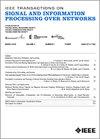Learning Optimal Graph Filters for Clustering of Attributed Graphs
IF 3
3区 计算机科学
Q2 ENGINEERING, ELECTRICAL & ELECTRONIC
IEEE Transactions on Signal and Information Processing over Networks
Pub Date : 2025-06-02
DOI:10.1109/TSIPN.2025.3574855
引用次数: 0
Abstract
Many real-world systems can be represented as graphs where the different entities in the system are presented by nodes and their interactions by edges. An important task in studying large datasets with graphical structure is graph clustering. While there has been a lot of work on graph clustering using the connectivity between the nodes, many real-world networks also have node attributes. Clustering attributed graphs requires joint modeling of graph structure and node attributes. Recent work has focused on combining these two complementary sources of information through graph convolutional networks and graph filtering. However, these methods are mostly limited to lowpass filtering and do not explicitly learn the filter parameters for the clustering task. In this paper, we introduce a graph signal processing based approach, where we learn the parameters of Finite Impulse Response (FIR) and Autoregressive Moving Average (ARMA) graph filters optimized for clustering. The proposed approach is formulated as a two-step iterative optimization problem, focusing on learning interpretable graph filters that are optimal for the given data and that maximize the separation between different clusters. The proposed approach is evaluated on attributed networks and compared to the state-of-the-art methods.学习属性图聚类的最优图过滤器
许多现实世界的系统可以用图形表示,其中系统中的不同实体由节点表示,它们的相互作用由边表示。图聚类是研究具有图形结构的大型数据集的一个重要任务。虽然在使用节点之间的连通性进行图聚类方面有很多工作,但许多现实世界的网络也有节点属性。聚类属性图需要对图结构和节点属性进行联合建模。最近的工作集中在通过图卷积网络和图过滤将这两个互补的信息源结合起来。然而,这些方法大多局限于低通滤波,不能明确地学习聚类任务的滤波器参数。在本文中,我们介绍了一种基于图信号处理的方法,其中我们学习了用于聚类优化的有限脉冲响应(FIR)和自回归移动平均(ARMA)图滤波器的参数。提出的方法是一个两步迭代优化问题,重点是学习对给定数据最优的可解释图过滤器,并最大化不同聚类之间的分离。提出的方法在属性网络上进行了评估,并与最先进的方法进行了比较。
本文章由计算机程序翻译,如有差异,请以英文原文为准。
求助全文
约1分钟内获得全文
求助全文
来源期刊

IEEE Transactions on Signal and Information Processing over Networks
Computer Science-Computer Networks and Communications
CiteScore
5.80
自引率
12.50%
发文量
56
期刊介绍:
The IEEE Transactions on Signal and Information Processing over Networks publishes high-quality papers that extend the classical notions of processing of signals defined over vector spaces (e.g. time and space) to processing of signals and information (data) defined over networks, potentially dynamically varying. In signal processing over networks, the topology of the network may define structural relationships in the data, or may constrain processing of the data. Topics include distributed algorithms for filtering, detection, estimation, adaptation and learning, model selection, data fusion, and diffusion or evolution of information over such networks, and applications of distributed signal processing.
 求助内容:
求助内容: 应助结果提醒方式:
应助结果提醒方式:


